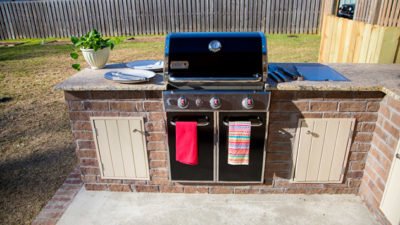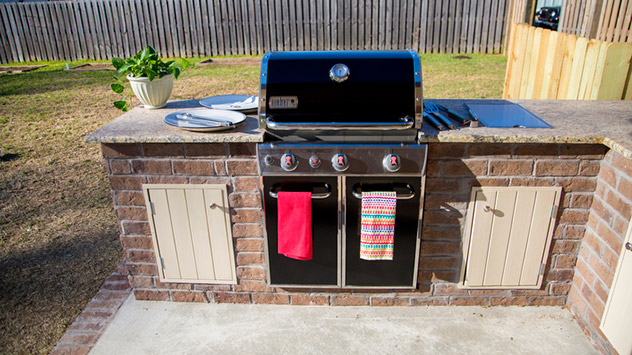[ad_1]

Our take on cabinets for an outdoor kitchen starts with a frame of pressure-treated 2x4s. We attach the boards together on edge to maximize space inside the cabinet. Countersinking inch and a half deep holes in the outer edges of the boards allows us to connect them with 3-inch deck screws.
Your situation and location will determine the dimensions of your cabinets, but don’t forget to account for the thickness of the materials that will form the outer skin of the cabinet. In this case, there will be a layer of cement backer board with split bricks glued over it like tile. Those materials add up to 1-1/4 inches we need to accommodate. We also leave openings for doors and a gap to insert the gas grill.
Because of the weight of the frames, we move them into position before we add the backer board. The frames are square and need to be level, but the patio slab has a slight slope to drain water, so we have to shim up the frame on the low end before we attach the frames to the wall and the slab. The backer board can then be cut to fit the frames and cover the gap created by the shims before we attach it to the frames with screws.
In the spots where we’ll locate doors, we have built frames out of 1x4s. These frames will give us a place to mount the cabinet door hinges and cap the raw ends of the brick around each door.
We purchased the same bricks used to build the house and cut off the outer faces using a large wet saw. We secure them to the backer board using thin-set adhesive approved for outdoor use.
In this case our pattern will match the “running bond” style of the house, and we start at the bottom to line up with the lowest row on the house. We apply the thin-set with a 1/4 x 1/4-inch square notched trowel, much like you would for a tile floor. The mortar joints on the house are a 1/2-inch thick, and I recommend using plastic spacers for this job.
Once the bricks dry overnight we begin applying the grout, or mortar, between the bricks. We mix up ordinary mortar mix with a fairly thin consistency because we’re using a grout bag to apply it to the cabinet.
Once the mortar is in the grooves, it needs to be sculpted to look like the mortar joints on the house. To do this we use a tuck pointing trowel.
Finally, the cabinets are ready for doors. To mimic the V-groove material on the back porch ceiling, we bevel pieces of pressure treated 1×4 and attach them to a piece of 1/2-inch plywood with exterior wood glue and brad nails.
Once the doors are painted to match the house, we mount them on the frames around each opening to complete our outdoor cabinets.
[ad_2]
Source link


